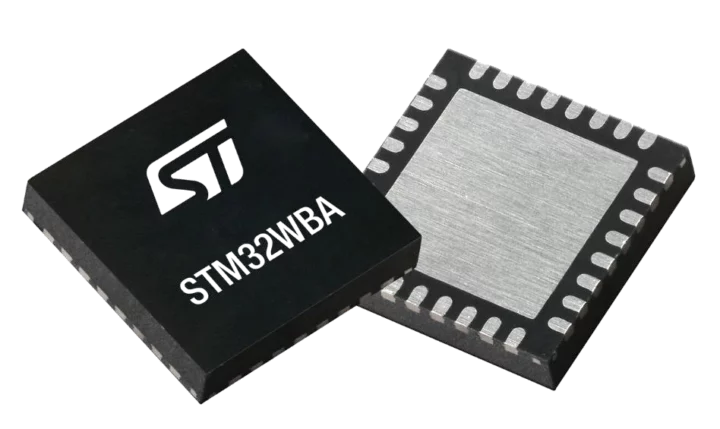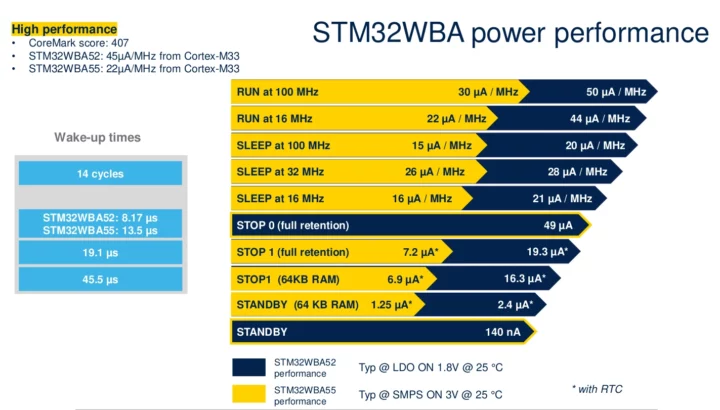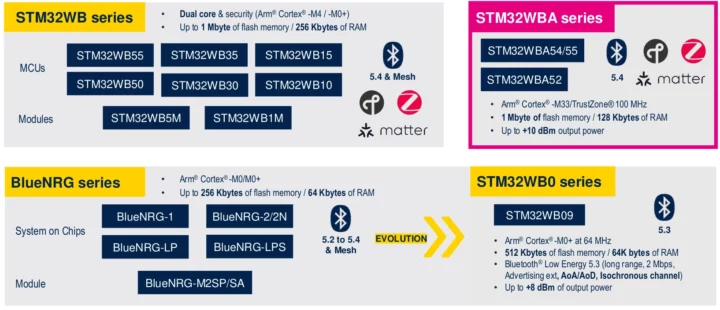STMicro’s new STM32WBA series, starting with the STM32WBA52, STM32WBA54, and STM32WBA55 devices, is a family of Arm Cortex-M33 wireless microcontrollers with Bluetooth LE 5.4, Zigbee, Thread, and Matter connectivity that achieved the SESIP (Security Evaluation Standard for IoT Platforms) Level 3 security certification and should make them compliant with US Cyber Trust Mark and EU Radio Equipment Directive (RED) regulations due to become mandatory in 2025.
The 100MHz STM32WBA54 and STM32WBA55 microcontrollers come with up to 1MB of flash memory, support Arm TrustZone architecture isolating secure processes and storage, and incorporate background autonomous mode, flexible power-saving states, and analog and digital peripherals found in STMicro STM32U5 ultra-low-power MCUs.
STM32WBA54 and STM32WBA55 specifications:
- MCU core – Arm Cortex-M33 at 100MHz with FPU and DSP
- Memory – Up to 128KB SRAM
- Storage – Up to 1 MB flash
- Wireless
- Bluetooth Low Energy 5.4
- Long Range (LR) capable
- Up to 2 Mbps
- Bluetooth LE audio support
- -96 dBm sensitivity
- Up to 20 links for multipoint communication
- Embedded balun + matching to lower design cost
- 802.15.4 radio
- Zigbee, OpenThread, Matter
- 106dBm RF link
- +10 dBm output power with low power consumption
- External PA support to get ultra-wide communication distance
- Concurrent mode
- Bluetooth Low Energy 5.4
- Peripherals
- 2x SPI, 2x I2C, up to 35x GPIOs
- 2x USART, LPUART
- Audio – 1-ch SAI
- Analog – 12-bit ADC up to 2 Msps, 2x ULP comparator
- Capacitive Touch
- 32-bit timer, 4x 16-bit timers (1x for motor control), 2x 16-bit ULP timers
- Security
- Arm TrustZone
- AES, PKA side attack resistant
- RTC active tamper enabled
- SESIP Level 3 target certification: compliance with the US Cyber Trust Mark and the EU Radio Equipment Directive (RED)
- Secure radio update and stack firmware with SBSFU/SFI
- Authenticated firmware upgrade system
- Power management
- Supply Voltage – 1.71 V to 3.6V
- LDO/DCDC support
- Switched-mode power supplies (SMPS) for low-power applications (STM32WB55 only)
- Power Consumption
- < 140 nA standby mode
- 0.9 μA in ULP-mode with full RAM
- Down to 1.35μA with RTC and 64KB of RAM.
- 30 µA/MHz when running at 100MHz
- 5.2 mA BLE Radio Tx current
- Package – 32 to 59 pins QFN/BGA packages
- Temperature Range – Up to 105°C
- Process – Built using 40nm process technology
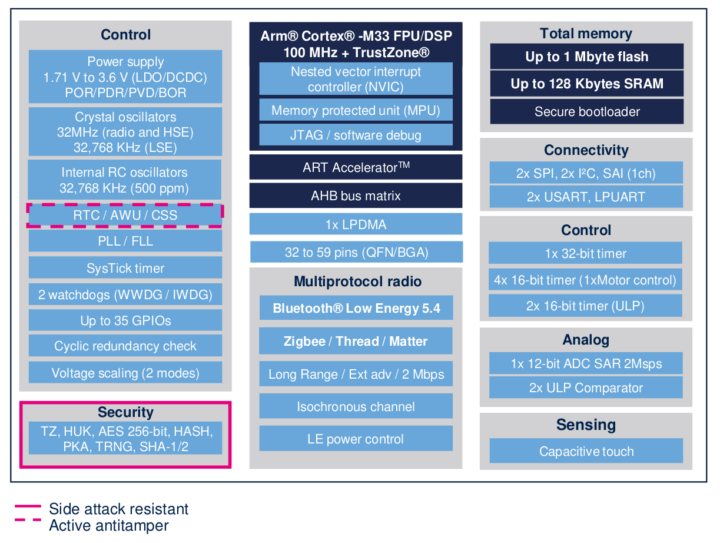
The STM32WBA52 microcontroller is a cost-down version with a Bluetooth LE 5.4 radio only, fewer peripherals, and different power consumption as shown in the table below. Note: the STM32WBA52 was tested with a 1.8V LDO and the STM32WBA55 with a 3V SMPS which explains the much different numbers in Amperes.
STMicro STM32WBA55 is a suitable candidate for Matter border routers, while Bluetooth LE Audio and Bluetooth Auracast support means STM32WBA32 will be found in portable audio devices such as earbuds.
The STM32WBA series adds to the existing STMicro STM32 wireless microcontrollers such as the STM32WB Cortex-M4/M0+ MCUs and STM32WB09 Cortex-M0+ microcontrollers building upon the BlueNRG series as shown in the illustration below.
STMicro offers both software development tools such STM32CubeWBA with a connectivity stack, examples, and peripheral drivers, STM32CubeMX for code generation and power calculation, STM32CubeMonRF for performance monitoring and ratio testing, and STM32CubeProg to program the application to the target, as well as STM32WBA52 and STM32WBA55 development boards with Arduino headers, such as the STM32WBA55G-DK1 Discovery kit and NUCLEO-WBA55CG Nucleo-64 board.
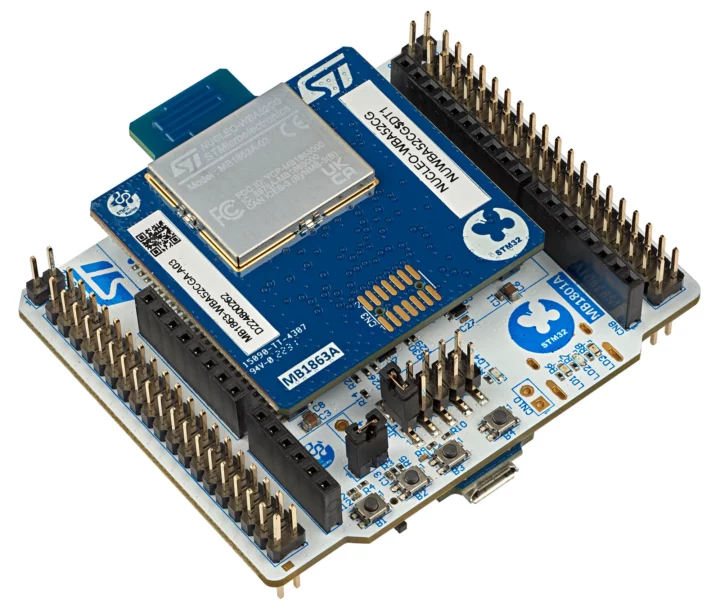
STMicro says samples are available now, but pricing requests must be made through the company’s sales office. The NUCLEO-WBA52CG development board is available now for $61.25 on STMicro eStore, An STM32WBA module with necessary external components including power supply and antenna-balancing circuitry should also become available in June 2024. More details may be found on the product page. Note: right now only the STM32WBA52 is shown, but details about the STM32WBA55 should be added by March 12 according to the press release.
Thanks to TLS for the tip.

Jean-Luc started CNX Software in 2010 as a part-time endeavor, before quitting his job as a software engineering manager, and starting to write daily news, and reviews full time later in 2011.
Support CNX Software! Donate via cryptocurrencies, become a Patron on Patreon, or purchase goods on Amazon or Aliexpress


